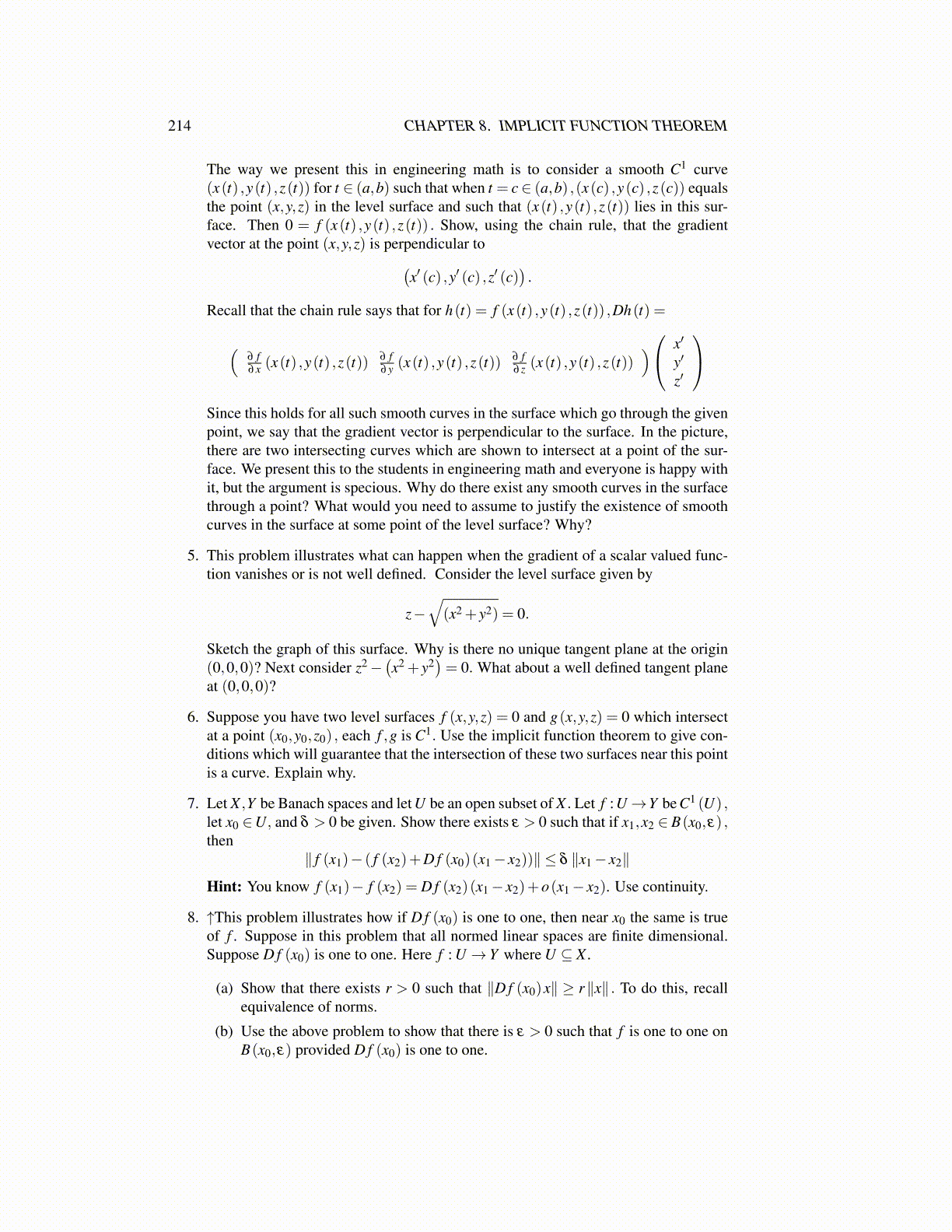
214 CHAPTER 8. IMPLICIT FUNCTION THEOREM
The way we present this in engineering math is to consider a smooth C1 curve(x(t) ,y(t) ,z(t)) for t ∈ (a,b) such that when t = c∈ (a,b) ,(x(c) ,y(c) ,z(c)) equalsthe point (x,y,z) in the level surface and such that (x(t) ,y(t) ,z(t)) lies in this sur-face. Then 0 = f (x(t) ,y(t) ,z(t)) . Show, using the chain rule, that the gradientvector at the point (x,y,z) is perpendicular to(
x′ (c) ,y′ (c) ,z′ (c)).
Recall that the chain rule says that for h(t) = f (x(t) ,y(t) ,z(t)) ,Dh(t) =
(∂ f∂x (x(t) ,y(t) ,z(t))
∂ f∂y (x(t) ,y(t) ,z(t))
∂ f∂ z (x(t) ,y(t) ,z(t))
) x′
y′
z′
Since this holds for all such smooth curves in the surface which go through the givenpoint, we say that the gradient vector is perpendicular to the surface. In the picture,there are two intersecting curves which are shown to intersect at a point of the sur-face. We present this to the students in engineering math and everyone is happy withit, but the argument is specious. Why do there exist any smooth curves in the surfacethrough a point? What would you need to assume to justify the existence of smoothcurves in the surface at some point of the level surface? Why?
5. This problem illustrates what can happen when the gradient of a scalar valued func-tion vanishes or is not well defined. Consider the level surface given by
z−√
(x2 + y2) = 0.
Sketch the graph of this surface. Why is there no unique tangent plane at the origin(0,0,0)? Next consider z2−
(x2 + y2
)= 0. What about a well defined tangent plane
at (0,0,0)?
6. Suppose you have two level surfaces f (x,y,z) = 0 and g(x,y,z) = 0 which intersectat a point (x0,y0,z0) , each f ,g is C1. Use the implicit function theorem to give con-ditions which will guarantee that the intersection of these two surfaces near this pointis a curve. Explain why.
7. Let X ,Y be Banach spaces and let U be an open subset of X . Let f :U→Y be C1 (U) ,let x0 ∈U, and δ > 0 be given. Show there exists ε > 0 such that if x1,x2 ∈ B(x0,ε) ,then
∥ f (x1)− ( f (x2)+D f (x0)(x1− x2))∥ ≤ δ ∥x1− x2∥
Hint: You know f (x1)− f (x2) = D f (x2)(x1− x2)+o(x1− x2). Use continuity.
8. ↑This problem illustrates how if D f (x0) is one to one, then near x0 the same is trueof f . Suppose in this problem that all normed linear spaces are finite dimensional.Suppose D f (x0) is one to one. Here f : U → Y where U ⊆ X .
(a) Show that there exists r > 0 such that ∥D f (x0)x∥ ≥ r∥x∥ . To do this, recallequivalence of norms.
(b) Use the above problem to show that there is ε > 0 such that f is one to one onB(x0,ε) provided D f (x0) is one to one.